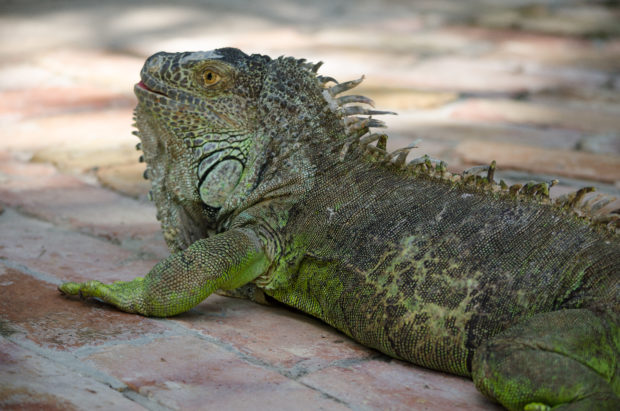
Even if the iguanas are humanely captured and killed, there is no science-backed evidence to show that such an approach will effectively reduce the state’s population of iguanas in the long term. Above, a green iguana recuperating at the South Florida Wildlife Center. Photo by Christine Capozziello/The HSUS
Florida, in the midst of an explosion in the population of green iguanas, is actively encouraging residents to kill the animals “whenever possible” around their homes or on public lands. This irresponsible directive from the state’s Fish and Wildlife Conservation Commission is not accompanied by any guidance on how such killing should be conducted, which all but ensures that the animals will be randomly pursued and persecuted, resulting in massive suffering and cruel deaths.
Even if the animals were humanely captured and killed, there is no science-backed evidence to show that such an approach will effectively reduce the state’s population of iguanas in the long term.
Last year we reported that the commission had hired contractors from the University of Florida to trap and kill iguanas either with bolt guns or by smashing their heads against hard objects. Conscripting Florida residents to kill the animals amplifies that archaic approach and reinforces a troubling message — that animals seen as “pests” or as a nuisance should be summarily killed.
It’s still worse that many Floridians are unlikely to be able to tell the difference between native and nonnative iguanas. Thus, this program of indiscriminate killing will likely adversely impact other lizards and iguanas who are likely to be misidentified and targeted by residents.
From time to time, we’ve found occasion and good reason to cooperate with the commission and to support its decisions. But this isn’t one of those times, not least because, again and again, when it comes to invasive species, Florida has disappointed us. Most conspicuously, it has failed to properly regulate the pet trade in wild and invasive species, which is a primary cause of the rise in populations of invasive amphibian and reptile species throughout the state. Florida is one of the very rare state wildlife agencies that does not recommend lethal control of coyotes for conflict reasons, and encourages humane solutions like education and hazing instead. We urge the commission to extend this progressive and humane attitude to iguanas.
More than 500 non-native fish and wildlife species have been observed in the state, and most of these got into Florida habitats through escape or unauthorized release from pet owners. As a result, there are Burmese pythons in the Everglades, Nile monitor lizards in Cape Coral and Cuban treefrogs in more than 36 Florida counties.
The green iguana, now being targeted, is one of three members of the iguana family established in mainland South Florida (the Mexican spiny-tailed iguana and the black spiny-tailed iguana are the others). Green iguanas have been in South Florida since the 1960s, likely rafting in from native home ranges as a result of hurricanes and other natural events. In the 1980s, the green iguana was top of the charts for the pet reptile trade, and as a result its population rocketed. Pet owners began releasing iguanas into the wild when they got too large, too aggressive or too sick. These former pets, along with escapees and refugees from exotic animal shipments, expanded their hold on areas around southern Florida’s bays, canals, ponds, impoundments and drainage ditches.
Climate change isn’t helping the situation either, because warming temperatures have made Florida an ever more hospitable range for these species. Iguanas are long-lived and fertile, and in the absence of predators and competitors for food, they are likely to expand northward into the state.
Here’s the bottom line. Attempting to reduce iguana populations without addressing the root causes of the problem will only result in a continuous cycle of killing, with no end in sight and no genuine relief from conflicts residents are experiencing.
The directive on iguanas is also creating unforeseen public safety problems: according to news reports an iguana hunter armed with a pellet gun shot and injured a man who was cleaning a pool at a residence in Boca Raton this week. A woman who spoke to the local media, said, “Iguanas are everywhere, if neighbors are gonna be like the Wild West and shoot at everything someone’s gonna get killed.”
What Florida needs is scientific, practical and humane solutions to the problem, beginning with a ban on the sale and trade of these animals. As of now the state still allows the sale of green iguanas and does not require a permit to possess green iguanas as personal pets. Iguanas released into the environment from this situation will continue to establish themselves no matter how many animals are killed.
The FWCC should also adopt a comprehensive and humane program for managing conflicts with iguanas, such as the one that they promote for solving conflicts with coyotes, one that takes into account the biology, habits and ecology of these species. The best conflict and population management programs are those that combine reproduction inhibition methods, including egg removal with habitat modification and public education on how to mitigate and reduce conflicts around the home. This might include installing barriers, removing plants that attract the animals, making nesting sites less suitable, and effective forms of hazing to keep the iguanas out of areas where they are not wanted.
Unless such common-sense methods are implemented, no amount of killing will end Florida’s iguana problem.
The post Florida’s inhumane solution to its iguana problem is doomed to failure appeared first on A Humane World.
Enviroshop is maintained by dedicated NetSys Interactive Inc. owners & employees who generously contribute their time to maintenance & editing, web design, custom programming, & website hosting for Enviroshop.
